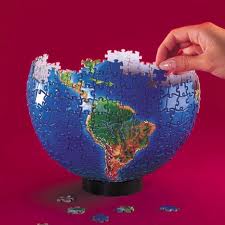
Does anyone know anything about IP rights (or lack thereof) in the jigsaw puzzle industry?
My son has recently become enamored with 3D puzzles and is currently working on a world globe like this one. So I was wondering if the jigsaw puzzle companies typically assert any IP rights in these creations. Obviously images on puzzles (2D or 3D) may be copyrighted if they are original and I’m sure some puzzle companies pay to license the images from others. But what about the puzzle itself? Is it a derivative work of the original image? Are aspects of puzzles patentable? I know at least one puzzle company advertises that it uses special new materials for the pieces that make them interlock more effectively. And 3D puzzles utilize particular methods for putting them together: for example, in the puzzles my son has been playing with, you can construct the puzzle either by image or by number (the backs of the pieces have consecutive numbers and arrows on them so you can use those as a guide for putting it together). Is that a patentable method of some kind? Presumably, in countries whose patent systems specifically exclude rules for playing games from patentability on subject-matter grounds (eg in the UK), these kinds of methods would not be patentable.
Anyone have any thoughts about copyrightability or patentability of puzzles?
If anyone is able to assert a copyright that includes the cut pattern, and not just the 2D design, it would be Stave. Looking over the list of clever tricks they use, though, starts to suggest that the cut pattern may well be uncopyrightable as a game or system.
A puzzle can be patented if it is a new and non-obvious structure. Examples of recent puzzle patents include:
– US 7,980,560, which relates to a 3-D puzzle made of interconnecting tubes, and
– US 7,918,497, which relates to a 3-D spherical puzzle.
The recent puzzle patents tend to cover quite complex structures — much more than a typical jigsaw puzzle. But I suppose that a complex structure makes a 3-D puzzle much more interesting to solve.
I’m vaguely remembering some dispute — not an opinion, but perhaps a filed case — over some sort of mosaic puzzle involving cars in a parking lot. In general though I don’t there are a lot of cases involving copyright in puzzles. (In patents, there’s the Rubik’s Cube case, where the solution to Rubik’s Cube was held to be a valid method patent IIRC.) Having just written an article on how games are systems, I’d be inclined to put puzzles in the same category for the same reasons, but I’d need to think about that a bit more.
Comments are closed.